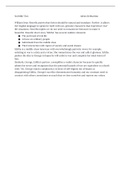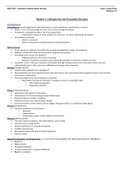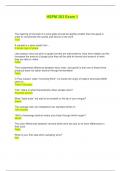H1: Gram Negatieve Coccen ............................................................................................................................. 3
Neisseriacea Familie ............................................................................................................................................ 3
Neisseria .......................................................................................................................................................... 3
Moraxella Catarrhalis (Branhamella) .............................................................................................................. 6
H2: Staalafname En Transport .......................................................................................................................... 7
Commensale Flora............................................................................................................................................... 7
Type Stalen .......................................................................................................................................................... 7
Correcte Staalafname.......................................................................................................................................... 8
PRE ANALYTISCHE FASE ................................................................................................................................... 8
Dringende Stalen En Staalbewaring .................................................................................................................. 12
Transportmateriaal ........................................................................................................................................... 13
POCT .................................................................................................................................................................. 15
Samengevat Pre-Analytisch Werk ..................................................................................................................... 15
H3: Strategie .................................................................................................................................................. 16
Keuze Van Cultuurbodems Voor Diverse Specimens ........................................................................................ 16
Urine.............................................................................................................................................................. 16
Bovenste Luchtwegen ................................................................................................................................... 20
Lagere Luchtwegen ....................................................................................................................................... 22
Lumbaal Vocht .............................................................................................................................................. 24
Punctievochten ............................................................................................................................................. 25
Wondvocht – Etter – Abces ........................................................................................................................... 25
Faeces ............................................................................................................................................................ 26
Samengevat Analytisch Werk ............................................................................................................................ 27
H4: Staphylococcen ........................................................................................................................................ 28
Staphylococcus Aureus ..................................................................................................................................... 29
CNS (Coagulase Negatieve Staphylokokken)..................................................................................................... 32
Samengevat Staphylococcen............................................................................................................................. 33
H5: Streptococcen .......................................................................................................................................... 34
Streptococcus Pyogenes ................................................................................................................................... 36
Streptococcus Agalactiae .................................................................................................................................. 38
Streptococcen Van Lancefield D........................................................................................................................ 40
Streptococcus Pneumoniae .............................................................................................................................. 42
Viridans En Niet-Hemolytische Streptococcen.................................................................................................. 44
Samengevat Streptococcen............................................................................................................................... 44
H6: Anaërobe Grampositieve Bacillen ............................................................................................................ 45
1
, Clostridium ........................................................................................................................................................ 45
C. Perfringens ................................................................................................................................................ 46
C. Botulinum .................................................................................................................................................. 48
C. Tetani ........................................................................................................................................................ 49
Andere Clostridia........................................................................................................................................... 51
H7: Aërobe Grampositieve Bacillen ................................................................................................................ 52
Bacillus .............................................................................................................................................................. 52
Bacillus Anthracis .......................................................................................................................................... 52
Bacillus CEREUS ............................................................................................................................................. 54
Bacillus Algemeen ............................................................................................. Error! Bookmark not defined.
Corynebacterium............................................................................................................................................... 55
Erysipelothrix .................................................................................................................................................... 57
Gardnerella ....................................................................................................................................................... 57
Lactobacillus ...................................................................................................................................................... 59
LISTERIA ............................................................................................................................................................. 60
Nocardia ............................................................................................................................................................ 62
H8: Chlamydia En Mycoplasmata ................................................................................................................... 63
Mycoplasmata ............................................................................................................................................... 63
Mycoplasma Pneumoniae ....................................................................................................................... 63
Mycoplasmata Hominis En Ureaplasma Urealyticum ..................................................................... 64
Chlamydia ....................................................................................................................................................... 66
C. Psittaci.................................................................................................................................................... 67
Chlamydia Trachomatis ........................................................................................................................... 67
C. Pneumoniae .......................................................................................................................................... 68
H9: Mycobacterium ................................................................................................................................... 69
M. Tuberculosis - Tuberculose .............................................................................................................. 72
H10: Spirochaetales .................................................................................................................................. 73
Treponema Pallidum .................................................................................................................................... 73
Borrelia ........................................................................................................................................................... 77
Leptospira....................................................................................................................................................... 78
Leptospira Interrogans ........................................................................................................................... 78
H11: Haccp .................................................................................................................................................. 79
De 7 Kernpunten Van Haccp ...................................................................................................................... 79
2
,BACTERIOLOGIE 2
H1: GRAM NEGATIEVE COCCEN
NEISSERIACEA FAMILIE
NEISSERIA
ALGEMENE BESCHRIJVING
• Onbeweeglijke, kleine, niervormige gramnegatieve diplokok
• In pus: intracellulair (WBC) en extracellulair
• Diplococcen aanwezig in WBC → waarschijnlijk N. meningitidis of Moraxella (niet bij Gonococcen)
• 11 species waarvan 2 pathogeen
o N. gonorrhoeae en N. meningitidis
o De 9 andere: commensalen in neus- en keelholte
• Oxidase +, behalve 1 → niet pathogeen dus ook niet belangrijk
• Katalase +
PATHOGEEN VERMOGEN
Strikt humane pathogenen!
Meningokok
• Wisselend % gezonde mensen (in nasofarynx) in de
normale flora = commensaal
• Transmissie: aerosolen van speekseldruppels
• Meestal asymptomatisch of lichte faryngitis (lichte
keelontsteking)
• Soms bacterie vanuit de farynx naar de BB → acute meningitis: zal zich snel manifesteren →
belangrijk om snel te handelen
• Huidbloedingen
• Intravasale stolling = stolling in de bloedbaan
Lokaal worden alle stollingsfactoren opgebruikt waardoor ze niet meer ter beschikking zijn elders
in de BB → bijnierbloedingen + shock = syndroom van Waterhouse-Frederichsen → dodelijk
3
, Meningitis = ontsteking van hersenvliezen
• Viraal: meest voorkomend, minder gevaarlijk
• Bacterieel: minst voorkomend, meest gevaarlijk
Op basis van een bloedtest kan men een onderscheidt maken tussen viraal en bacterieel, a.d.h.v. het
aantal WBC, het eiwitgehalte en het glucosegehalte.
Pathologie meningitis
Via het zeefbeentje (reukzenuwen maken contact met de centrale reukzenuw) kunnen de bacteriën in
de hersenvliezen terecht komen en zo infecties veroorzaken. Vooral te zien bij pasgeborene en bij
jonge kinderen. Er ontstaat een directe verspreiding (dus zeer besmettelijk).
Vaccinatie op jonge leeftijd: 15 maand; MenC.
Etiologie meningitis
1e kolom: de pasgeborene kan deze 3 bacteriën
(vetgedrukt) oplopen wanneer die geboren wordt
via het gewone geboortekanaal, deze kunnen
meningitis vanaf de geboorte veroorzaken.
(Salmonella: via voedselinfectie; Listeria: de
foetus loopt dit op via de moeder, G- bacterie
bevindt zich in zachte kazen. Listeria is de enige
bacterie die doorheen de placenta kan gaan en de
foetus kan besmetten.)
2e kolom: vooral N. meningitidis. Differentiaal diagnose a.d.h.v. gramkleuring (H. influenza en N.
meningitidis zijn G-, S. pneumoniae is G+).
H. infuenza is een coccobacil en Neisseria zijn diplococcen!
Gonokok
• Ontsteking van
o Urogenitale tractus
o Rectum
o Conjunctivae = bij pasgeborene waarvan de moeder geïnfecteerd was met gonokokken
• Veroorzaakt een SOA: gonorroe
o Vrouw: urethra → cervix → endometrium → eileider, verloopt asymptomatisch
o Bij bevalling → conjunctivis panoftalmie (aantasting van het gehele oog)
o Man: urethra à prostaat
4










